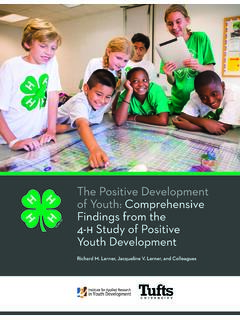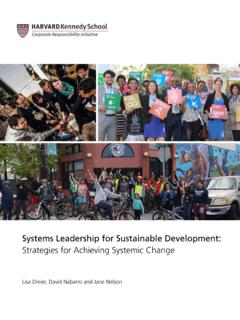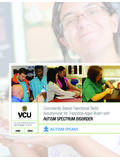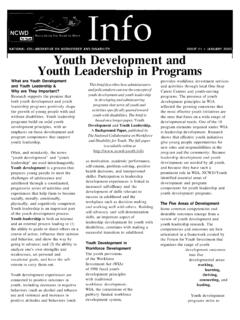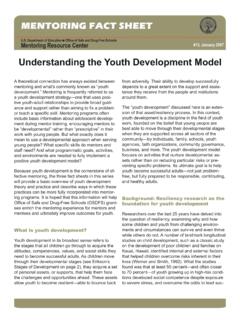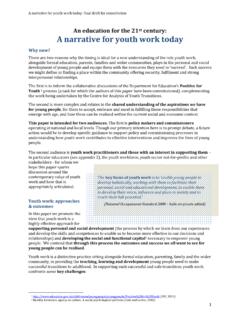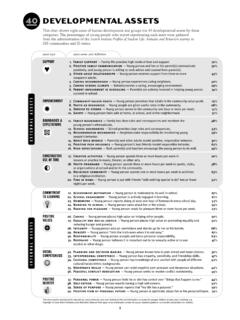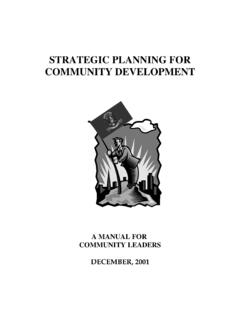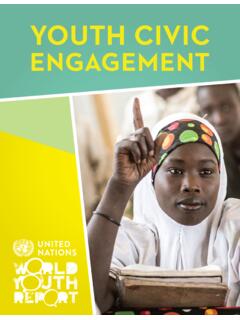Transcription of What Is Youth Development? - A Nation At Hope
1 Introduction The Youth development Work Group of the Aspen Institute National Commission on Social, Emotional, and Academic development offers this brief on the critical role of Youth development organizations in young people's growth and development . The brief presents a framework for broadening our understanding of how, when, and where students learn,i both in and out of school and during the summer. It recommends ways for educators, policymakers, and funders to partner with Youth development organizations and to capitalize on formal and informal learning settings that support young people's growth and development . What Is Youth development ? Positive Youth development is an inten- people's strengths; and promotes positive tional, prosocial approach that engages outcomes for young people by providing Youth within their communities, schools, opportunities, fostering positive relation- organizations, peer groups, and families in a ships, and furnishing the support needed to manner that is productive and constructive; build on their leadership strengths.
2 Inter- recognizes, utilizes, and enhances young agency Working Group on Youth 1. The Youth development approach emphasizes the people to grow while exploring interests and wrestling importance of meeting young people where they are with issues that reflect their passions and concerns. physically, academically, socially, and emotionally to help them build the relationships, competencies, and In the last decade, Youth development organizations confidence they need to succeed in life. While each have strengthened their collective capacity to increase Youth development organization operates differently, young people's access to quality learning settings, both their common denominator is the commitment to in and out of school as well as throughout the day and create supportive learning settings that nurture young year.
3 Partnering with public officials across the coun- people's strengths and interests and enable them to try, these organizations have created the state and thrive. Relationship building is at the heart of what local infrastructure needed to coordinate, measure, these organizations do. While an organization may be and improve their programming. They have worked known by its activities or content an arts program, a to ensure that learning activities are available in such sports league, an environmental camp young people hard-to-reach settings as rural communities and consistently voice a common refrain: they may initially housing projects, and they have sought to reach young be hooked by the activity, but they stay because of people in the digital world where they spend increasing the bonds they form with peers and adults.
4 Amounts of time. Youth development organizations span and are staffed The organizations' expanded capacity is due, in part, by every sector of the community nonprofits, faith- to the growing number of local and state afterschool based organizations, employers, businesses, civic and and summer learning systems and networks that are arts associations, and public agencies focused on rec- providing assessment and training aimed at increas- reation, health, safety, and learning. They range from ing access to quality Youth development experiences. afterschool programs and community centers to men- Often referred to as intermediaries, these organi- toring programs and summer camps. Their staff and zations represent cross-sector partnerships among volunteers work in and across systems and sectors, Youth development providers, city agencies, school meeting Youth wherever they are in schools, sports districts, employers, and other stakeholders who leagues, clubs and community centers, as well as in want to support the whole learner through a systems public housing, detention centers, homeless shelters, While there is still much to be learned, and hospitals.
5 Youth development organizations can and do partner with schools and districts. Together they prioritize and Youth development organizations provide myriad integrate social, emotional, cognitive, and academic learning opportunities in an array of settings. United development to address persistent achievement gaps in the belief that America's bedrock principle of equal and the needs of increasing numbers of Youth who are opportunity necessitates a balanced approach to learn- challenged by poverty. ing, these organizations recognize that learning is fun- damentally social, emotional, cognitive, and academic. They acknowledge that young people are learning all Where and When Learning Happens the time, both during and out of school, and in families, We now have 40 years of evidence to show how learn- neighborhoods, and communities.
6 They support an ing In order for all young people to benefit approach to learning that develops a broad set of skills, from this knowledge, our next goal is to expand our knowledge, and competencies needed to become a life- understanding of where and when learning happens . long learner, productive worker, and engaged citizen. or doesn't happen. And we must push far beyond the And they foster settings and services that allow young familiar in-school/out-of-school dichotomy. 2 BUILDING PARTNERSHIPS IN SUPPORT OF WHERE, WHEN, AND HOW LEARNING HAPPENS. Where and When Learning Happens Expanding our understanding of all the places and times young people grow and learn HOME SCHOOL COMMUNITY PEER. INTERACTION. Core academic classes DURING.
7 Elective classes SCHOOL. Family experiences and responsibilities Informal school spaces ( , cafeterias,hallways, libraries, buses). Extracurricular activities ( , clubs, mentoring, sports). Enrichment and development opportunities BEFORE/AFTER. SCHOOL, Civic and employment SUMMER. opportunities ( , service learning, volunteering, jobs). Community learning settings ( , libraries, museums, zoos, parks). Most young people start and end every day with their As illustrated in the graphic above, there are many families. The family is the central place where specific places and spaces that can and should contribute skills and competencies as well as broader attitudes to social, emotional, cognitive, and academic devel- and values are named and normed.
8 Families play an opment; it is the role of families, schools, and Youth active role in determining whether the other places development organizations to work together to ensure where young people spend their learning time are that they are all considered and adequately resourced. places that reinforce and respect the lessons they are Bolstered by data, communities can take bigger, bolder teaching at home. steps toward two goals: 1) shedding light on inequita- ble access to learning opportunities, and 2) providing Among the most critical decisions families make are guidance, incentives, and resources to ensure that selecting schools and identifying opportunities to accessible opportunities not only exist but reflect the broaden their children's learning and development .
9 Science of learning and development . Their options, however, can be constrained by avail- ability, affordability, quality, cultural or developmental The Commission's case study on the Tacoma Whole appropriateness, transportation, program hours, and Child Initiative illustrates one community's approach neighborhood safety. For example, an examination to strategic Understanding that context of two national data sets found significant disparities matters, the following recommendations are intended in participation in afterschool and summer programs to give schools and Youth development organizations related to family income: Youth from higher-income, multiple entry points for working together, creating more educated families were more likely to enroll and connections or expanding upon what is already in participate in more diverse activities than children from place, and promoting new strategies and policies at less advantaged the building and district levels.
10 This work is not meant NATIONAL COMMISSION ON SOCIAL, EMOTIONAL, AND ACADEMIC development 3. THE EVIDENCE BASE FOR HOW LEARNING HAPPENS: SKILLS, ATTITUDES, AND CHARACTER TRAITS FOR SUCCESS. More than two decades of demonstrate are important to on core ethical standards such as research across a wide range of successful learning. integrity, honesty, compassion, disciplines psychology, social diligence, civic and ethical engage- science, brain science, and oth- These skills and competencies ment, and responsibility. ers demonstrate that a variety develop and are used in dynamic of skills, attitudes, and values are interaction with ATTITUDES, These dimensions of learning embedded in and support how BELIEFS, AND MINDSETS intertwine to promote accom- learning happens.

